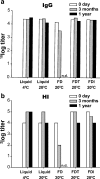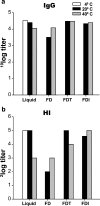Preservation of the immunogenicity of dry-powder influenza H5N1 whole inactivated virus vaccine at elevated storage temperatures
- PMID: 20195930
- PMCID: PMC2844510
- DOI: 10.1208/s12248-010-9179-z
Preservation of the immunogenicity of dry-powder influenza H5N1 whole inactivated virus vaccine at elevated storage temperatures
Abstract
Stockpiling of pre-pandemic influenza vaccines guarantees immediate vaccine availability to counteract an emerging pandemic. Generally, influenza vaccines need to be stored and handled refrigerated to prevent thermal degradation of the antigenic component. Requirement of a cold-chain, however, complicates stockpiling and the logistics of vaccine distribution. We, therefore, investigated the effect of elevated storage temperatures on the immunogenicity of a pre-pandemic influenza A H5N1 whole inactivated virus vaccine. Either suspended in liquid or kept as a freeze-dried powder, vaccines could be stored for 1 year at ambient temperature (20 degrees C) with minimal loss of immunogenicity in mice. Elevation of the storage temperature to 40 degrees C, however, resulted in a significant loss of immunogenic potency within 3 months if vaccines were stored in liquid suspension. In sharp contrast, freeze-dried powder formulations were stable at 40 degrees C for at least 3 months. The presence of inulin or trehalose sugar excipients during freeze-drying of the vaccine proved to be critical to maintain its immunogenic potency during storage, and to preserve the characteristic Th1-type response to whole inactivated virus vaccine. These results indicate that whole inactivated virus vaccines may be stored and handled at room temperature in moderate climate zones for over a year with minimal decline and, if converted to dry-powder, even in hot climate zones for at least 3 months. The increased stability of dry-powder vaccine at 40 degrees C may also point to an extended shelf-life when stored at 4 degrees C. Use of the more stable dry-powder formulation could simplify stockpiling and thereby facilitating successful pandemic intervention.
Figures




Similar articles
-
Physical and immunogenic stability of spray freeze-dried influenza vaccine powder for pulmonary delivery: comparison of inulin, dextran, or a mixture of dextran and trehalose as protectants.Eur J Pharm Biopharm. 2013 Nov;85(3 Pt A):716-25. doi: 10.1016/j.ejpb.2013.07.018. Epub 2013 Aug 8. Eur J Pharm Biopharm. 2013. PMID: 23933147
-
A spray dried replicon vaccine platform for pandemic response.Int J Pharm. 2025 Jul 25;680:125777. doi: 10.1016/j.ijpharm.2025.125777. Epub 2025 May 26. Int J Pharm. 2025. PMID: 40436220
-
Development of a Freeze-Dried, Heat-Stable Influenza Subunit Vaccine Formulation.PLoS One. 2016 Nov 16;11(11):e0164692. doi: 10.1371/journal.pone.0164692. eCollection 2016. PLoS One. 2016. PMID: 27851765 Free PMC article.
-
Development of stable influenza vaccine powder formulations: challenges and possibilities.Pharm Res. 2008 Jun;25(6):1256-73. doi: 10.1007/s11095-008-9559-6. Pharm Res. 2008. PMID: 18338241 Free PMC article. Review.
-
Prepandemic influenza vaccine H5N1 (split virion, inactivated, adjuvanted) [Prepandrix]: a review of its use as an active immunization against influenza A subtype H5N1 virus.BioDrugs. 2008;22(5):279-92. doi: 10.2165/00063030-200822050-00001. BioDrugs. 2008. PMID: 18778110 Review.
Cited by
-
Induction of heterosubtypic cross-protection against influenza by a whole inactivated virus vaccine: the role of viral membrane fusion activity.PLoS One. 2012;7(1):e30898. doi: 10.1371/journal.pone.0030898. Epub 2012 Jan 27. PLoS One. 2012. PMID: 22303469 Free PMC article.
-
Stabilization of a recombinant ricin toxin A subunit vaccine through lyophilization.Eur J Pharm Biopharm. 2013 Oct;85(2):279-86. doi: 10.1016/j.ejpb.2013.03.029. Epub 2013 Apr 10. Eur J Pharm Biopharm. 2013. PMID: 23583494 Free PMC article.
-
Development of an Orodispersible Film Containing Stabilized Influenza Vaccine.Pharmaceutics. 2020 Mar 8;12(3):245. doi: 10.3390/pharmaceutics12030245. Pharmaceutics. 2020. PMID: 32182676 Free PMC article.
-
Exploring the Origins of Low-Temperature Thermochromism in Polydiacetylenes.Polymers (Basel). 2024 Oct 10;16(20):2856. doi: 10.3390/polym16202856. Polymers (Basel). 2024. PMID: 39458684 Free PMC article. Review.
-
Characterization and Immunogenicity of Influenza H7N9 Vaccine Antigens Produced Using a Serum-Free Suspension MDCK Cell-Based Platform.Viruses. 2022 Aug 31;14(9):1937. doi: 10.3390/v14091937. Viruses. 2022. PMID: 36146744 Free PMC article.
References
-
- World Health Organization http://www.who.int/mediacentre/news/statements/2009/h1n1_pandemic_phase6....
-
- Update: novel influenza A (H1N1) virus infections—worldwide, May 6, 2009. MMWR Morb Mortal Wkly Rep. 2009;58:453-8. - PubMed
Publication types
MeSH terms
Substances
LinkOut - more resources
Full Text Sources
Other Literature Sources
Medical

